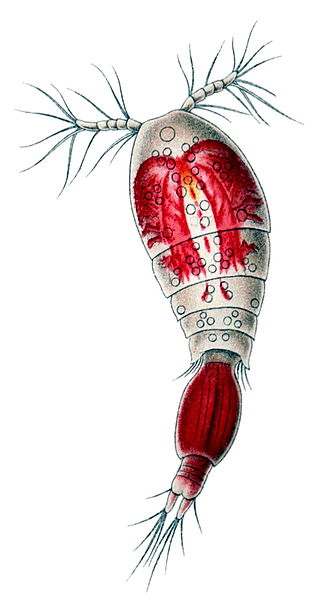
Tantulocarida is a highly specialised group of parasitic crustaceans that consists of about 33 species, treated as a class in superclass Multicrustacea. They are typically ectoparasites that infest copepods, isopods, tanaids, amphipods and ostracods.
Cumoniscidae is a family of crustaceans in the class Tantulocarida, classified under the superclass Multicrustacea. The family was previously known as Deoterthridae, but Cumoniscidae was determined to be senior subjective synonym.

The Cyclopoida are an order of small crustaceans from the subclass Copepoda. Like many other copepods, members of Cyclopoida are small, planktonic animals living both in the sea and in freshwater habitats. They are capable of rapid movement. Their larval development is metamorphic, and the embryos are carried in paired or single sacs attached to first abdominal somite.

Canthocamptidae is a family of copepods. Most of the 700 species are confined to fresh water, although there are also marine species. It contains the following genera:

Ectinosomatidae is a family of the Harpacticoida, a huge group of crustaceans belonging to the subclass Copepoda. Like most of their relatives, they are usually benthic inhabitants of marine environments. Ectinosomatidae commonly inhabit sediment and fragments of dead corals or glass sponges, and occasionally algae and bryozoans, in the deep oceans. In the epifaunal species, the first leg pair is often modified to allow the animals a better grip on the substrate.
Paralubbockia longipedia is a species of copepod, and the only member of the family Paralubbockiidae. The family is characterised by the ventral position of the fifth legs, the possession of a separate maxillary palp, and the form of the endopods of the legs and antennae. The closest relatives of Paralubbockia are the family Oncaeidae. Initially placed among the Poecilostomatoida, Paralubbockia is now considered part of the Cyclopoida.
Lubbockiidae is a family of cyclopoid copepods in the order Cyclopoida. There are about 7 genera and 15 described species in Lubbockiidae.
The Chitonophilidae are a family of parasitic copepods, with these genera:

Oncaea venusta is a species of copepod with a cosmopolitan distribution, but lacking from the Arctic Ocean. Females are 1.1–1.3 mm (0.043–0.051 in) long, while males are only 0.8–1.0 mm (0.031–0.039 in) long. The front of the head is unusually wide, and the body is brightly coloured, usually yellow–orange, but sometimes red. O. venusta feeds on a variety of zooplankton and phytoplankton.

Oncaea is a genus of copepods. The genus contains bioluminescent species. Unlike other bioluminescent copepods, Oncaea have an internal (non-secreted) bioluminescence. Oncaea contains the following species:
Stygotantulus is a genus of crustacean with the sole species Stygotantulus stocki. It lives as an ectoparasite on harpacticoid copepods of the families Tisbidae and Canuellidae. It may be the the smallest arthropod in the world, at a length of less than 0.1 millimetres (0.004 in). The specific name stocki commemorates Jan Hendrik Stock, a Dutch carcinologist.
Centropagidae is a family of copepods in the order Calanoida. Its members are particularly known as plankton in coastal waters and in fresh water in Australia and southern South America. They are also found on subantarctic islands and in lakes in Antarctica.

Gelyella is a genus of freshwater copepods which are "surrounded by mystery". They live in groundwater in karstic areas of southern France and western Switzerland. The two species are the only members of the family Gelyellidae and, although previously placed in the order Harpacticoida, a new order, Gelyelloida, was erected for this family alone.
Geoffrey Allan Boxshall FRS is a British zoologist, and Merit researcher at the Natural History Museum, working primarily on copepods.
Speleophriidae is a family of copepods, comprising seven genera. All are restricted to anchialine caves, with the exception of Archimisophria, which is found in the hyperbenthos of the depths of the Atlantic Ocean. The genera are:

The clade Multicrustacea constitutes the largest superclass of crustaceans, containing approximately four-fifths of all described crustacean species, including crabs, lobsters, crayfish, shrimp, krill, prawns, woodlice, barnacles, copepods, amphipods, mantis shrimp and others. The largest branch of multicrustacea is the class Malacostraca.
Basipodellidae is a family of crustaceans belonging to the order Hexanauplia.
Tisbidae is a family of copepods belonging to the order Harpacticoida.
Canuellidae is a family of copepods belonging to the order Polyarthra.

Misophriidae is a family of copepods belonging to the order Misophrioida.








